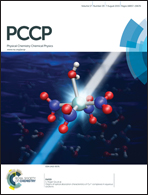The dynamics of adsorption and dissociation of N2 in a monolayer of iron on W(110)
Abstract
We study the adsorption dynamics of N2 on an expanded monolayer of Fe grown pseudomorphically on W(110). To this aim we have performed molecular dynamics simulations in a six-dimensional potential energy surface calculated within density functional theory. Our results show that N2 dissociation on this surface is a highly activated process with an energy barrier of around 1.25 eV. Regarding molecular adsorption, we find that the energetically most favorable adsorption well corresponds to a parallel orientation of the molecule with an adsorption energy of around 520 meV. However, at low molecular energies and surface temperatures, the molecules preferentially adsorb vertically to the surface with an adsorption energy of around 480 meV. A comparative analysis with the results previously obtained on a clean Fe(110) surface shows that while surface strain favors molecular adsorption of N2 in this system, it impedes dissociative adsorption. The former is consistent with the experimental observations showing that the inertness of Fe(110) towards N2 uptake is reduced in the strained surface. The latter leads us to suggest that the experimental observation of dissociated atomic N in the strained surface when increasing surface temperature must be related to the presence of step/defects at the surface.


 Please wait while we load your content...
Please wait while we load your content...